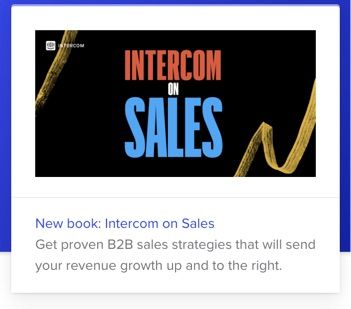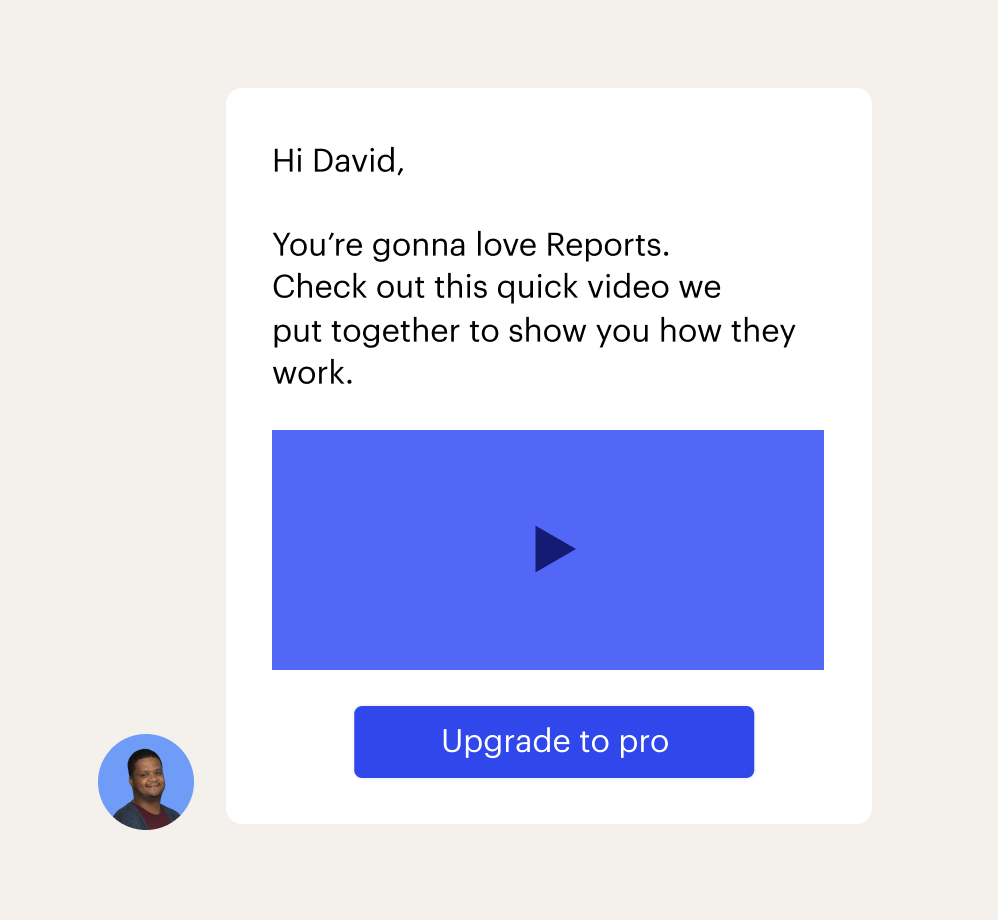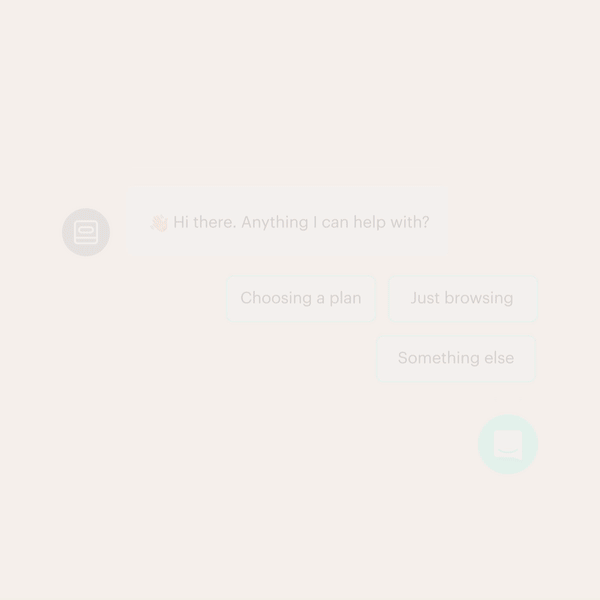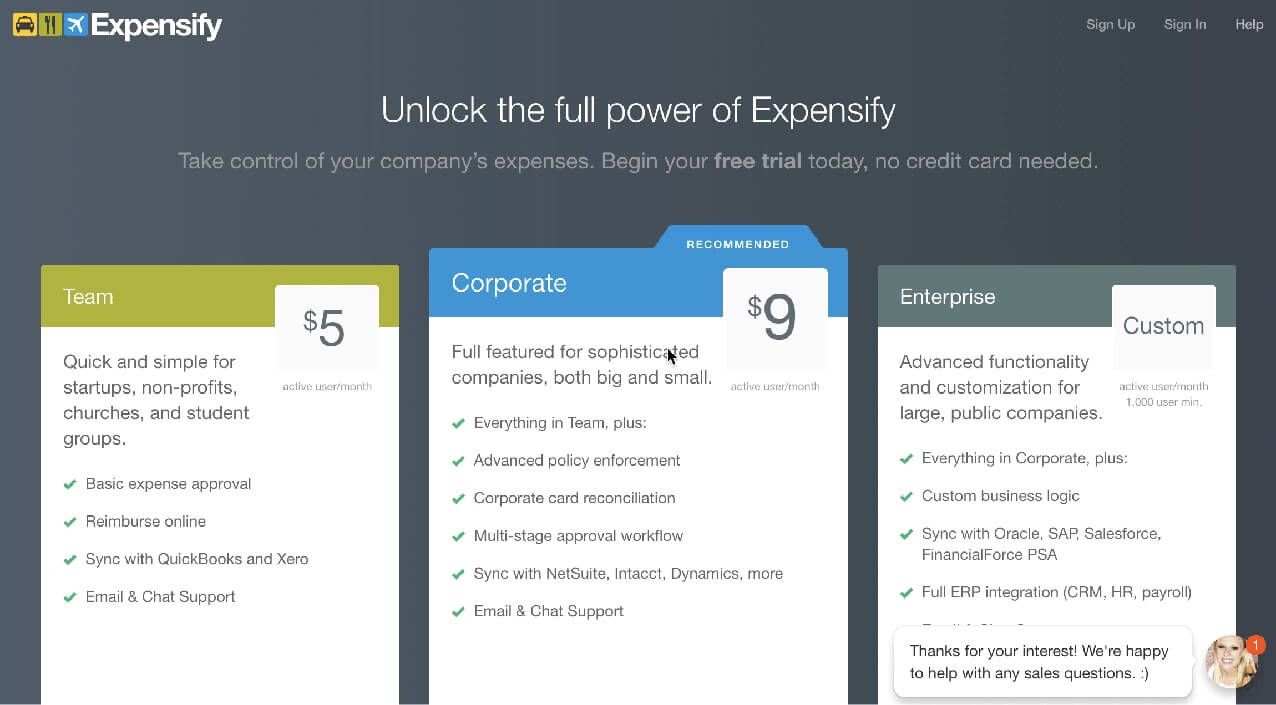
Does live chat really work for marketing?
Main illustration: Justin Cassano
Your potential customers see dozens, sometimes hundreds, of marketing messages every day and everywhere: on social media, on their phones, on billboards as they drive down the street.
But this kind of marketing has a low success rate. Why? It’s all about context.
When a prospect is watching TV or running errands, they’re not thinking about what kind of software to buy for their business. Any marketing messages they see then are effectively out of context. But when they’re actively shopping, a message telling them which service or product to pick — and explaining why — is perfectly within the context of what they’d expect. And as it turns out, these contextual messages are also much more likely to drive them to action.
Live chat is a prime example of a contextual marketing method: your potential customers get the opportunity to chat with you, right on your website, and at the exact time they’re thinking about purchasing your product or service.
“Prospects who chat are 82% more likely to convert than non-chatters”
Done well, live chat for marketing can drive more sales, and reduce the amount of time it takes to convince a prospect to purchase in the first place.
Let’s take a deep dive into how live chat can effectively be used as a marketing method and look at some best practices for contextual chat messages on your own site.
What is live chat for marketing?
Live chat for marketing is a software tool that allows companies to communicate in real-time with prospects who visit their website for the purpose of generating sales. If you’re already using live chat for sales or live chat for support, it makes sense to also use it for marketing to drive lead generation campaigns.
How do you incorporate live chat into your marketing strategy?
There are several ways you can build out your marketing strategy with live chat. Sharing resources, upselling and proactively asking prospects questions are a few of the most impactful ways to start.
Share relevant resources
Live chat messages can be customized and triggered based on a user’s search intent or completed events.
For example, we recently published the blog post Everything we’ve learned about scaling sales, where we share our favorite expert advice on accelerating startup growth. People reading this article are likely growth leaders looking to drive more revenue – and therefore interested in our new book, Intercom on Sales, talking about proven sales plays for accelerating growth.
By showing a live chat marketing message promoting the book on the blog article, we can offer additional resources to our readers – and also generate more leads and convert blog visitors in the process.

Market or upsell new product functionality
Blog articles, press releases, and email aren’t always fail-safe ways to alert current customers when a new feature is released or when an important update has been made to their service.
Live chat messages, however, can be triggered to pop up for customers the moment they land on your web page or app. These pop-up messages can be personalized using customer names and data, making them more likely to grab their attention. Use this opportunity to market new features and functionalities for an existing or new product.

Proactively ask prospects questions about their needs
Live chat can be an excellent resource for lead generation and qualification on high-intent parts of your site like pricing pages or marketing landing pages.
For example, let’s say a lead lands on your pricing page. This is a good indication that the lead is worth pursuing — but more information is needed to properly qualify and assist them. Use live chat to attain this information in one of two ways:
- One-way communication with bots: Using Custom Bots, you can help users get quick answers to key questions or schedule a meeting with a rep — with just the click of a button. This pre-qualification saves both the prospect and the sales rep time, effectively shortening the customer journey.

- Two-way communication with real-time chat support: Show quick-answer questions to encourage leads to chat with you and see if they have questions. If they reply, route the conversation to a sales rep in real time. Two-way live chat is especially useful if your leads tend to ask complex questions about pricing, products, or services.

4 reasons to add live chat to your marketing playbook
The effectiveness of live chat is higher than you might expect: one Facebook study showed that 53% of customers are more willing to spend with a business that has chat platform functionality on their website. Additionally, our own research revealed that prospects who chat spend roughly 13% more when they make a purchase.
If these statistics don’t convince you, here are four additional reasons you should consider live chat as the next addition to your marketing technology stack.
1. You can talk to potential customers in the right context, right away
Prospects are on your site for a reason: to learn more about you, ask questions, get pricing, and make an informed decision. Live chat allows you to reach those people in the right context and at the right moment.
For example, let’s say a potential customer is nearly ready to purchase one of your services. They click through to the pricing page on your website but are confused about the differences between two of your service plans.
“45% of website visitors are more likely to convert on pages other than the homepage”
Starting a conversation with a potential customer in this exact moment could mean the difference between making and losing a sale. In fact, research revealed that website visitors are “82% more likely to convert to customers if they’ve chatted with you first.” Luckily, live chat can be triggered to do so based on user behavior within the website. In this example, triggering behaviors may be:
- Anytime a user visits the “Pricing” page on your website
- When time on the “Pricing” page is more than one minute
- Based on the number of visits to the “Pricing” page (e.g., >1)
Remember, any page on a website can be integrated with live chat. Believe it or not, 45% of website visitors are more likely to convert on pages other than the homepage. Think about which web pages drive the most conversions or intrigue. Determine why a visitor may land on that page, and tailor your live chat accordingly.
2. Live chat speeds up the sales cycle
Live chat allows potential customers to instantly connect with representatives at the exact moment they’re ready to buy or when they’re most in need of information. Maintaining a short response time, therefore, can speed up the sales cycle.
A study by the Harvard Business Review found that firms reaching out to prospects within an hour of the initial contact were 7x more likely to qualify their leads than those who performed their outreach after that period had passed.
Connecting with prospects the moment they show interest not only speeds up the sales cycle, but it also keeps leads from going cold and being lost altogether. Live chat can be automated to achieve this instant connection based on a user’s behavior on your website:
- Visiting a specific page
- Requesting a free trial
- Filling out a web form
One example of this type of behavior may be a website visitor filling out an online form subscribing to your company’s email marketing newsletter. Live chat can be triggered to initiate automatically between that visitor and a sales rep once the form subscription has been completed, ensuring prospects are contacted the moment they show interest.
3. Contextual data allows you to send better messages
The best live chat software lets you use customer behavior data from other channels (email, web visits, etc.) to score leads and send more targeted live chat messages. For example, Intercom integrates with Clearbit to automatically add social and company data to new user profiles, allowing for more personalized messaging. You can also enrich your data with our MadKudu integration, a predictive scoring app that helps sales reps identify high-value leads.
Furthermore, the best live chat software should provide insights for past live chat campaigns internally. For example, how many people downloaded that ebook you advertised via chat? Which types of conversations were most successful at converting customers? Do quick-response answers improve the conversion rate, or do your customers prefer chatting with a real person?
Utilize data enrichment and the data collected from your live chat campaigns to improve future chats and messaging.
4. Chatbots make 24/7 engagement a reality
If you have a small sales team, it might not be possible for you to have someone available to chat with customers 24/7. Fortunately, chatbots can step in when your sales team is out of office or busy. In fact, because chatbots can respond faster to basic inquiries than humans, their conversion rate is 36% higher.
“Chatbots have a higher conversation rate than humans because they can respond faster”
In fact, because chatbots can respond faster to basic customer inquiries than humans, their conversion rate is 36% higher.
On the other hand, if a bot is incapable of answering a question, they can instantly connect your prospect with a human team member who can. Overall, chatbots help your sales team continuously engage prospects on your site in the most efficient way possible.
Live chat for marketing best practices
Now that you know why live chat is such a valuable tool for marketers, let’s dig into how you can use it successfully. Here are some of the best practices to keep in mind when you build live chat into your marketing flow — or, alternately, start using chatbots to send marketing messages to potential customers.
Target high-intent pages
Think about why users visit the various pages on your website. Consider the intent for each page, and use that knowledge to craft live chat marketing messages that answer that intent. For example:
- Your website’s pricing page: If a visitor lands here, it’s likely they’re interested in your product and potentially looking to buy. Use this information to send automated messages like, “Do you have any questions about our pricing plan?” The goal is to be proactive about letting customers know you have answers to their specific questions.
- Product-specific landing pages: Many companies create specific landing pages for individual products or services. And because landing pages are commonly used in targeted marketing campaigns, visitors who land there are likely to be prospective customers. Utilize this opportunity to engage with leads via the chat:
- Offer a trial of the product.
- List the pain points your product specifically addresses, and ask visitors to identify which ones they struggle most with.
- Your website’s homepage: There are an endless number of reasons someone might land on your website’s homepage. Find out what your visitor is looking for with questions like:
- “What brings you to [company website] today?”
- “Hey there! Interested in learning how our product can help with x, y, and z?”
Identify which pages on your company’s website have the highest customer intent, whether that intent is to learn more, subscribe to a newsletter, or purchase a product. These pages provide the best opportunities for using targeted messages to convert customers or drive them further down the sales funnel.
Lead with a question
The goal of live chat marketing is to get website visitors to engage with your brand. The best way to accomplish this is to start by asking your visitor a direct question — and the more specific, the better:
Bad example:
- “Let us know if you need anything.” (not a question)
- “We’re here to answer your questions.” (also not a question)
Good example:
- “How can we help you today?”
- “Are you interested in learning more about [name of product]?”
Great example:
- “What kind of revenue goal do you have for Q4 of this year?”
- “Would you like a demo of how [feature x] and [feature y] can improve [customer pain point 1] and [customer pain point 2]?”
These types of specific, targeted questions help initiate conversations with potential customers so that you may get a better understanding of what those customers need and how you can help.
Set achievable goals
Remember, not all campaigns will be successful right from the start. Making your live chat campaign goals realistic, targeted, and measurable will keep reps and support from feeling too overwhelmed or discouraged.
Furthermore, the more specific and measurable your goals are, the more beneficial the resulting data will be for future campaigns. Some examples of specific goals may be to:
- Increase ebook downloads by 25% in one month with the use of chat.
- Convert 100 customers via the pricing page chat in one month’s time.
- Generate five qualified leads within one week via the homepage chat.
For the three example goals above, it’s a good idea to A/B test messages and campaign types to determine what resonates most with your target customer base.
Monitor, test, and improve your chats
Now that you have realistic and measurable goals set, the next step is to monitor your efforts to determine what’s working and what could be improved upon. Look at conversion and response rates to identify which campaigns are performing better than others and which are performing poorly.
From here, you can adjust your campaigns accordingly by experimenting with various aspects of chat such as:
- Cadence (when and how frequently will messages be sent to visitors?)
- Type (direct questions, offers, ebook downloads, other CTAs)
- Chat triggers (what events will prompt your chats to pop up? E.g., page visits, time on page, etc.)
It’s best practice to change only one variable at a time when testing campaigns. Otherwise, it will be too difficult to identify what exactly helped improve campaign results.
Rely on chatbots — but be transparent about it
Live chat is most effective when it comes to having detailed conversations with customers. Of course, chatbots are incredibly useful time- (and money) savers when it comes to collecting lead data or answering simple customer inquiries. That being said, maintaining a healthy customer relationship built on trust requires transparency.
When naming your chatbot avoid human names or fake photos; label them as a bot, so users know exactly who, or what, they’re talking to. Additionally, let users know what they can expect after submitting a chat. If a human isn’t available to speak with a customer yet, create an auto message like “a representative will be with you in 5 minutes,” or “we’ll look in our knowledge base for an answer…”
Finally, make the “escape hatch” easy to find and use. Users should feel like they have the option to speak with you, rather than feel bombarded with an obtrusive chatbot they can’t get rid of.
5 companies using live chat for marketing
To help you put these ideas into action, let’s take a close look at how five Intercom customers have found success with live chat for marketing, and what they’ve done to increase sales and grow their business with chat long-term.
1. Expensify
Based out of San Francisco, Expensify helps customers with online expense management. They use live chat site-wide for marketing, plus support and sales. Integrating Intercom’s live chat capabilities with their website has resulted in:
- Faster response time
“Since migrating to Intercom, Expensify has brought down response time to customers and leads to roughly 30 minutes, less than half the previous time, while managing even more conversations a month.” - Lower acquisition cost
“It’s costly to acquire a single customer, so having a single tool that lets us track, coach, and support users through every step of the funnel is priceless.”
2. Copper
Copper (formerly ProsperWorks) is a popular CRM with over 10,000 customers and over 150 employees. They currently use Intercom to:
- Capture and message top-of-funnel leads
“We use Intercom to target leads coming in from paid sources. We saw that these leads were leaving our site without engaging with the page they landed on. With Intercom, we capture their attention and offer a way to engage with us directly, so they can ask questions that may not be answered on the page. We’ve also placed Intercom on our pricing page, so our sales team can answer questions at a pivotal point in a lead’s decision-making process.” - A/B test
Copper utilized Intercom’s A/B testing feature to measure the performance of different versions of the same message.
In just one month, Copper achieved the following results using Intercom:
- 13% increase in website conversion rate over forms
- 19 new sales opportunities
- $36k in annual recurring revenue added to pipeline
3. Tradeshift
A platform for business commerce, Tradeshift processes more than $500 billion in yearly transactions for their customers. They implemented Intercom to help improve the efficiency of their sales cycle, and as a result, were able to:
- Generate better, faster leads and speed up the qualification process:
“Before Intercom, the average time for SDRs to qualify a lead and reach a stage-one sales opportunity was 21 days including four touchpoints, such as marketing emails, webinars, and website visits. ‘With Intercom,’ Adam proudly explains, ‘the time it took to surface real project opportunities and receive RFPs decreased from 21 days to 3 days. We’re able to identify and engage leads faster than ever before.” - Increase qualified sales opportunities by 32%:
“By adding the visitor auto message, we saw a substantial increase in visitors who request sales help and, as a result, more stage-one opportunities,” Kate explains. “It’s a really pleasant, helpful interaction that gets the conversation going.”
4. Unity
Unity is a B2B company offering 3D dev in real-time. They began using Intercom to:
- Connect potential paying customers with inside sales more quickly
- Upsell to potential “pro subscription” subscribers
- Answer customer questions more quickly
- Capture low-hanging fruit and grow their inside sales team
- Target users on high-intent pages
Within three months of implementing Intercom, Unity was able to drive 80% of sales revenue by live chat. Additionally, Intercom helped Unity:
- Generate revenue faster than ever before
- Increase visitor to paid conversion rates by 45% in their online store
- Attribute 10% of saved churns to auto messages on their cancellation page
“We have an online store, and we had visitors abandoning our site because they had questions and no way to get them answered quickly. Intercom has enabled us to have a channel to be proactive and communicate in an instant. In particular, Visitor Auto Messages allowed us to generate revenue faster than we would have otherwise and increased our visitor to paid conversion rates by 45% in our online store.”
5. Droplr
A file-sharing company whose products are heavily influenced by the customer, Droplr credits Intercom with “turning their customer communication into a valuable resource across the company.” The team at Droplr uses Intercom for a variety of functions, including:
- Welcome campaigns
- Onboarding
- Customer retention
- Team-specific campaigns
- Support
- Marketing
- Sales
Droplr also segments users based on their operating system and uses Intercom to automatically send instructions for their product to users depending on what operating system is detected. This helps ensure their customers only receive information relevant to them.
In a recent release of their Chrome extension:
“Not only were we able to target users based on their preferred browser, but because we’re able to clearly explain the feature in context, it’s reduced the volume of support conversations we typically answer around new features.”
Using Intercom, Droplr was able to:
- Increase customer retention by 32%
- Increase downloads and engagement with new features
Live chat is an invaluable part of every marketing toolkit
Successful marketing is all about context: reaching the right person in the right place at the right time. With live chat, you can nail this context without spending a fortune on complicated lead routing tools or extensive external marketing campaigns. Simply set up a few rules, customize your chatbots, and you’re ready to go.
If you’re ready to get started, build your first support bot with Intercom now. We’ll be there to help every step of the way!









